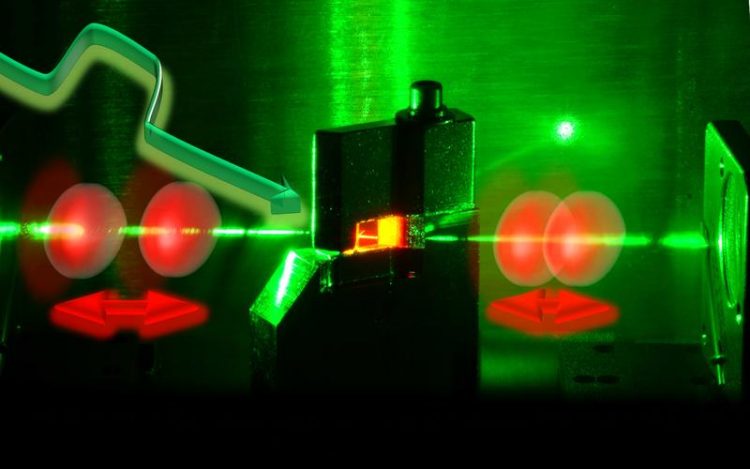Always on beat: ultrashort flashes of light under optical control

Light pulses can form pairs in ultra-short pulse lasers. The pulse intervals (red) can be precisely adjusted by making certain changes to pump beam (green). Image: UBT
Laser pulses have long been utilized in research laboratories, industrial production, and medical therapies. In these applications it is often crucial that the pulses – also known as optical solitons – occur at certain intervals.
Using a special high-speed measurement technique, the researchers have now been able to show how a short-pulse laser widely applied in research can be made to automatically generate pairs of light pulses separated by the desired interval.
All that is required are small disturbances in the green optical “pump beam” (which generates the laser pulses) triggered by electric signals.
The new process centres on the targeted manipulation of solitons, wave packets that can occur in pairs in ultrashort laser pulses. “The resonance excitation and the short disturbance of soliton pairs trigger effects that can be used to specifically control ultrashort laser pulses.
This opens up an exciting new area of research with a yet unforeseeable range of possible applications,” said Prof. Dr. Georg Herink from Bayreuth, corresponding author of the new study. “At the right frequency, a tiny external modulation of the laser is all you need, and ultrashort laser pulses are set into reciprocal, resonant oscillation.
Similar phenomena can be observed in water molecules heated in the microwave,” added lead author Felix Kurtz from Göttingen.
The newly published findings show that in the future, ultra-short pulse lasers will not only be considered as a tool, but also remain a fascinating object of research.
Prof. Dr. Georg Herink
Experimental Physics VIII
University of Bayreuth
Phone: +49 (0)921 / 55-3161
E-mail: georg.herink@uni-bayreuth.de
F. Kurtz, C. Ropers, G. Herink: Resonant excitation and all-optical switching of femtosecond soliton molecules. Nature Photonics (2019), DOI: http://dx.doi.org/10.1038/s41566-019-0530-3
Media Contact
More Information:
http://www.uni-bayreuth.de/All latest news from the category: Physics and Astronomy
This area deals with the fundamental laws and building blocks of nature and how they interact, the properties and the behavior of matter, and research into space and time and their structures.
innovations-report provides in-depth reports and articles on subjects such as astrophysics, laser technologies, nuclear, quantum, particle and solid-state physics, nanotechnologies, planetary research and findings (Mars, Venus) and developments related to the Hubble Telescope.
Newest articles

iENA Silver Medal for Observer of Atoms
In the field of precision engineering and mechatronics systems, novel innovations shape the future of technologies like nano-fabrication technology and high-precision devices. Honoring Excellence: The IMMS Patent Recently, the IMMS…

Biodegradable Plastics from Waste
In a joint research, Bioprocess engineer Prof. Dr.-Ing. Sebastian Riedel from the Berlin University of Applied Sciences (BHT) and Prof. Dr. Jaewook Myung from the Korea Advanced Institute of Science…

NASA successfully integrates Roman mission’s telescope, instruments
NASA’s Nancy Grace Roman Space Telescope team has successfully integrated the mission’s telescope and two instruments onto the instrument carrier, marking the completion of the Roman payload. Now the team…



